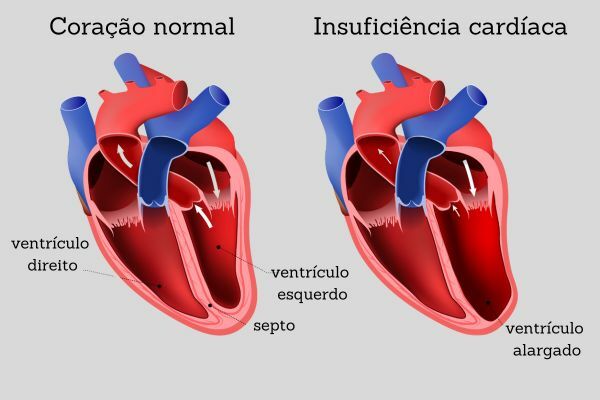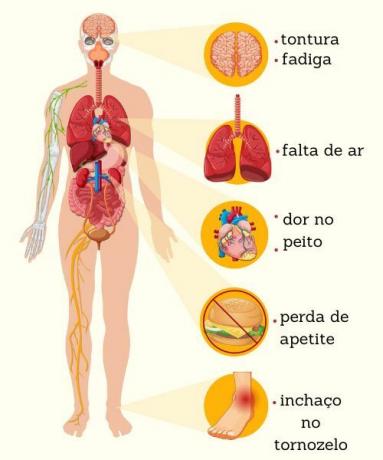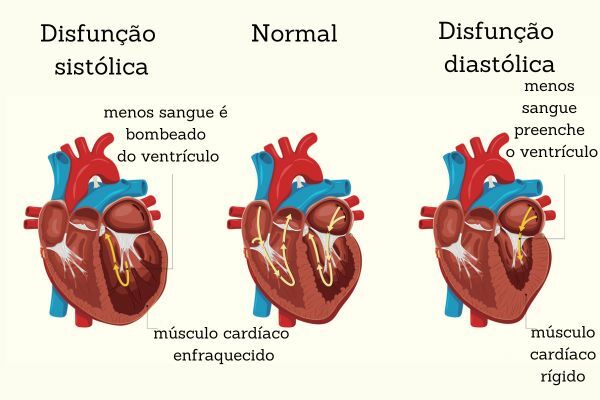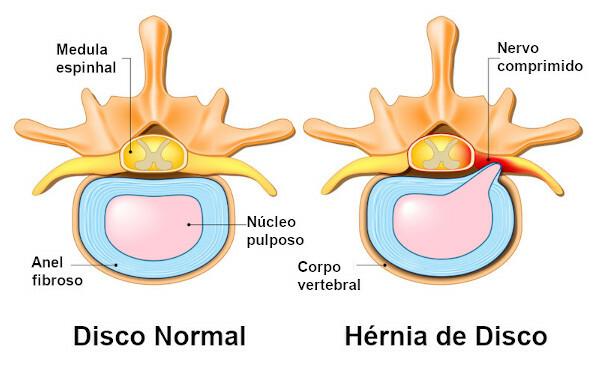A Congestive heart failureHeart failure, or just heart failure, is a condition in which the heart cannot pump blood effectively, leading to fluid buildup in the lungs and other parts of the body. Its causes include cardiomyopathy, high blood pressure and congenital heart problems. Factors such as smoking and alcohol consumption can also contribute. Symptoms include fatigue, shortness of breath, swelling in the legs and ankles, and a persistent cough.
Diagnosis involves tests such as an echocardiogram and blood tests. Treatment includes lifestyle changes, management of underlying conditions, medications to improve heart function, and, in severe cases, surgical interventions such as a heart transplant. Proper follow-up can improve patients' quality of life and minimize complications.
Read too: What are the symptoms of a heart attack?
Topics of this article
- 1 - Summary of heart failure
- 2 - What is heart failure?
- 3 - How does a healthy heart work?
- 4 - Causes of heart failure
- 5 - How does the body try to compensate for the decrease in blood flow?
- 6 - What are the symptoms of heart failure?
- 7 - What are the stages of heart failure?
- 8 - Diagnosis of heart failure
- 9 - Treatment of heart failure
- 10 - Types of heart failure
- 11 - Can heart failure be cured?
- 12 - Risk factors for heart failure
- 13 - Prevention of heart failure
summary of heart failure
Heart failure is a condition that occurs when the heart cannot pump blood effectively.
Its causes include coronary artery disease, cardiomyopathy, high blood pressure, diabetes, and lifestyle factors such as smoking and alcohol consumption.
Symptoms include chest pain, fatigue, shortness of breath, swelling and persistent coughing.
Heart failure is divided into four stages, which require different care.
Diagnosis uses blood tests and imaging to assess heart function and identify possible underlying causes.
Treatment includes changes in lifestyle, control of associated diseases, medications for improve heart function and, in severe situations, surgical procedures such as transplantation cardiac.
What is heart failure?
Congestive heart failure, also known as heart failure, is a chronic condition in which the heart cannot pump blood efficiently to meet the demands of the body. In this scenario, the heart remains active, but faces difficulties in managing and adapting to the necessary amount of blood, resulting in the accumulation of this fluid in other parts of the body.
This condition continues to be globally prevalent, leading to high rates of morbidity and mortality. Estimates indicate that around 26 million people are affected worldwide.
Do not stop now... There's more after the publicity ;)
How does a healthy heart work?
The heart, a hollow muscular organ, is about the size of a fist and weighs about 300g on average. Integrates the cardiovascular system and plays a fundamental role in the body: pumping the adequate amount of blood to every corner of the body. Its structure encompasses four distinct chambers, with two upper compartments known as the atria and two lower ones known as the ventricles.
O right atrium is responsible for receiving oxygen-poor blood from the rest of the body and propelling it through the right ventricle to the lungs, where oxygenation occurs. Oxygen-enriched blood returns from the lungs to the left atrium and is subsequently directed to the Left ventricle, responsible for pumping it to all parts of the body.
To ensure the proper pace, it is important that these four chambers beat in a coordinated way. A healthy heart has the pumping capacity that meets the basic needs of blood circulation, thus ensuring adequate blood flow throughout the body. Learn more about how the heart works by clicking here.

Causes of heart failure
The causes of heart failure are diverse, including:
coronary artery disease (obstruction of the coronary arteries, vessels responsible for irrigating the heart muscle);
heart attack (death of cells in a region of heart muscle);
congenital heart disease (heart problems present from birth);
cardiomyopathy (set of diseases that affect the heart muscle, which may be genetic or viral);
diabetes;
arrhythmia (irregular heartbeat, too fast or too slow);
kidney disease;
hypertension (high blood pressure);
excessive consumption of alcohol and tobacco.
See too: What are the main causes of death in the world?
How does the body try to compensate for the decrease in blood flow?
In the early stages of the disease, the heart tries to overcome the difficulty of pumping blood around the body by expanding more significantly, stretching to contract with greater vigor and meet the body's demand for blood pumping. Over time, this effort results in an increase in the dimensions of the heart.

One Another commonly adopted strategy is to increase cardiac muscle mass., which increases the pumping power of the heart. In this context, the growth of muscle mass is associated with an increase in the organ's contractile cells. Another mechanism involves an increase in heart rate..
The body as a whole also engages. Blood vessels constrict to preserve high blood pressure, as an attempt to compensate for reduced cardiac output. The kidneys, in turn, begin to retain more salt and water, instead of excreting them in the urine.
This results in an increase in blood volume., which contributes for maintaining blood pressure and thus for the heart to pump more efficiently. However, over time, this excess volume can overload the heart, aggravating heart failure.
What are the symptoms of heart failure?
Symptoms of heart failure vary from mild to severe, and may be intermittent. The main symptoms of heart failure are:
Shortness of breath, which is the most common symptom of the disease, especially during physical activity and when sleeping.
Chest pain.
Palpitations due to increased heart rate to compensate for pumping.
Fatigue during physical activity, a symptom that worsens over time, making it difficult to even carry out basic activities such as taking a shower.
Swelling in the abdomen, ankles and legs and weight gain due to the accumulation of fluid in the tissues (oedema), which leads to weight gain.
Pain in the abdomen due to the accumulation of fluid in the region, especially in the liver and digestive system.
Loss of appetite and nausea, as the disease affects the proper functioning of the digestive system.
Dry and persistent cough due to the accumulation of fluid in the lung.

In general, this condition tends to get worse over time, making the initial symptoms more intense and leading to other complications, such as:
irregular heartbeat;
sudden cardiac arrest;
pulmonary hypertension;
kidney damage;
malnutrition;
heart valve problems;
liver injury.
What are the stages of heart failure?
Heart failure is a disease that progressively worsens. As it evolves, the heart further reduces its effectiveness in boosting blood flow throughout the body. This ailment is characterized by four distinct stages:
Stage A: it is configured as a pre-heart failure stage, indicating that the individual has a high risk of developing the disease. Such risk derives from positive family history for the condition and the presence of conditions such as hypertension, diabetes, cardiomyopathy, coronary artery disease, rheumatic fever, among others. others. In addition, factors such as a history of alcohol consumption and the use of certain medications, such as used in the treatment of cancer, are also considered in the categorization of patients at this stage.
Stage B: this stage is also framed as a pre-heart failure stage. In this scenario, the left ventricle does not function properly and/or manifests structural abnormalities. However, symptoms of the disease are not yet evident.
Stage C: it is characterized as the symptomatic phase of heart failure. Individuals in this stage receive a confirmatory diagnosis for the disease and manifest symptoms related to the condition.
Stage D: encompasses patients who are in an advanced stage of heart failure, presenting severe symptoms that do not respond or improve with conventional treatments.
Diagnosis of heart failure
Diagnosis of heart failure involves integrating the clinical examination with assessment of symptoms, lifestyle and family history of the patient, in addition to imaging tests and blood tests. Among the exams used are the electrocardiogram, the cardiac computed tomography, the echocardiogram, the magnetic resonance heart rate, chest X-ray and multiple acquisition scintigraphy.
This comprehensive approach helps in identifying the presence of the disease, as well as in determining the stage and underlying cause that has weakened or stiffened the heart muscle.
heart failure treatment
The necessary treatment will depend on both the stage of heart failure and the causes that led to this condition. The main objective of treatment is to prevent the progression of the patient to more advanced stages of the disease, since regression of stages is not possible.
in the early stages, the therapeutic protocol usually consists of a combination of lifestyle changes and medication administration. It is recommended to adopt healthy practices, including the practice of moderate and supervised physical exercises, adherence to a cardiovascular treatment program and the reduction of sodium, alcohol and tobacco intake. Different classes of medicines are available, varying according to the individual needs of the patient, such as vasodilators and beta blockers.
As the disease progresses for more advanced stages and conventional treatment proves to be insufficient, heart transplantation option may be considered. This intervention involves replacing the dysfunctional heart with a healthy donor heart.

types of heart failure
Heart failure can occur in the left ventricle or the right ventricle:
Left ventricular heart failure: occurs when the left side has to work harder to pump the same amount of blood. She is divided into systolic and diastolic insufficiency. In systolic failure, the left ventricle loses its ability to contract normally and lacks the strength to push enough blood to the rest of the body. In diastolic failure, the left ventricle loses its ability to relax the chambers. heart and cannot adequately fill with blood during the rest period between each beat. In both cases, there is a decrease in the percentage of blood the heart pumps out.. A normal heart pumps 55 to 60% of the blood it contains. In systolic and diastolic insufficiency there is a reduction to 40% and 50%, respectively.

Right ventricular heart failure: normally occurs as a result of left side failure. When the left ventricle fails and cannot pump enough blood out, fluid pressure builds up and backs up through the lungs, damaging the right side of the heart. When the right side loses its ability to pump, blood pools in the body's veins.
Is heart failure curable?
heart failure It is a chronic condition, requiring lifelong treatment.. However, with proper care, in most cases, it is possible to enjoy a life with few restrictions. Prognosis, which assesses the course of a medical condition, depends on several factors, including the severity of the symptoms, cardiac muscle functionality, response to treatment, and adherence to the rehabilitation plan cardiovascular.
Know more: Which organs can be donated?
Risk factors for heart failure
Risk factors associated with heart failure include:
use of tobacco, alcohol and other drugs;
sedentary lifestyle;
consumption of foods high in salt and fat;
history of heart attack;
family history of heart failure;
arterial hypertension;
presence of coronary artery disease;
age above 65 years.
prevention of heart failure
Although there are risk factors that cannot be changed, such as age and genetic predisposition, it is possible to adopt lifestyle changes that reduce the likelihood of developing heart failure. Some measures include:
incorporate the regular practice of physical exercises;
reduce or avoid the consumption of alcohol, tobacco and other harmful substances;
avoid excessive consumption of salt, fat and ultra-processed foods;
manage stress;
take care of other medical conditions that may contribute to the development of heart failure.
Sources
AMERICAN HEART ASSOCIATION. Types of Heart Failure. In: American Heart Association. Available in: https://www.heart.org/en/health-topics/heart-failure/what-is-heart-failure/types-of-heart-failure.
ARRIGO, M. et al. Acute heart failure. Nat Rev Dis Primers. 2020. 6: 16.
CLEVELAND CLINIC. Understanding Heart Failure. In: Cleveland Clinic. Available in: https://my.clevelandclinic.org/health/diseases/17069-heart-failure-understanding-heart-failure.
TEAM PORTAL DRAUZIO VARELLA.Congestive heart failure: symptoms, causes and available treatments. In: Website Drauzio Varella. Available in: https://drauziovarella.uol.com.br/cardiovascular/insuficiencia-cardiaca-congestiva-sintomas-causas-e-tratamentos-disponiveis/.
INAMDAR, A.A. & INAMDAR, A.C. Heart Failure: Diagnosis, Management and Utilization. J Clin Med. 2016. 5(7):62.
JUNQUEIRA, L.C.U. & CARNEIRO, J. Basic Histology. 12 ed. Rio de Janeiro: Guanabara Koogan, 2013. 558 p.
KEMP, C.D. & CONTE, J.V. The pathophysiology of heart failure. Cardiovascular Pathol. 2012. 21(5):365-71.
KING, M. et al. Diagnosis and evaluation of heart failure. Am Fam Physician. 2012. 85(12):1161-8.
MALIC, A. et al. Congestive Heart Failure. In: StatPearls. Treasure Island (FL): StatPearls Publishing. 2022. Available in: https://www.ncbi.nlm.nih.gov/books/NBK430873/.
SERVICES AND INFORMATION FROM BRAZIL. Treatment of heart failure. In: gov.br. Available in: https://www.gov.br/pt-br/servicos-estaduais/tratamento-de-insuficiencia-cardiaca-1#:~:text=A%20insufici.
SWEDBERG, K. Heart failure subtypes: Pathophysiology and definitions. Diabetes Research and Clinical Practice. 2021. 75: 108815.
Click here, learn about the 10 main causes of death in the world and learn a little more about each of these problems.
Check out everything you need to know about the human heart, a hollow organ made up of four chambers that ensures blood is sent throughout the body.
Density, heart disease, low-density lipoproteins, bad cholesterol, cell walls arteries, good cholesterol, high-density lipoproteins, LDL, HDL, myocardial infarction, stroke cardiac.
Do you know who can donate organs and which organs can be donated? Click here and find out the answer to this and other questions!
Rheumatic fever: cause, symptoms and treatment.
Click and understand what hypertension is, its symptoms, how the diagnosis is made and what the treatment of this health problem consists of.
Chest pain and shortness of breath are symptoms of a heart attack. Click here and learn more about this problem that kills thousands of people annually in Brazil.
Find out a little more about what cardiorespiratory arrest is and its consequences, and also understand the importance of quick help in this case.
Expand your knowledge about the cardiovascular system, the system in our body responsible for ensuring blood circulation in the body.
Click here and understand what heart transplantation is. Check out how the transplant queue works and what the risks and costs of the operation are.


